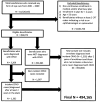A longitudinal analysis of risk factors associated with central retinal vein occlusion
- PMID: 23177364
- PMCID: PMC3563864
- DOI: 10.1016/j.ophtha.2012.07.080
A longitudinal analysis of risk factors associated with central retinal vein occlusion
Abstract
Purpose: To identify risk factors associated with central retinal vein occlusion (CRVO) among a diverse group of patients throughout the United States.
Design: Longitudinal cohort study.
Participants: All beneficiaries aged ≥ 55 years who were continuously enrolled in a managed care network for at least 2 years and who had ≥ 2 visits to an eye care provider from 2001 to 2009.
Methods: Insurance billing codes were used to identify individuals with a newly diagnosed CRVO. Multivariable Cox regression was performed to determine the factors associated with CRVO development.
Main outcome measures: Adjusted hazard ratios (HRs) with 95% confidence intervals (CIs) of being diagnosed with CRVO.
Results: Of the 494 165 enrollees who met the study inclusion criteria, 1302 (0.26%) were diagnosed with CRVO over 5.4 (± 1.8) years. After adjustment for known confounders, blacks had a 58% increased risk of CRVO compared with whites (HR, 1.58; 95% CI, 1.25-1.99), and women had a 25% decreased risk of CRVO compared with men (HR, 0.75; 95% CI, 0.66-0.85). A diagnosis of stroke increased the hazard of CRVO by 44% (HR, 1.44; 95% CI, 1.23-1.68), and hypercoagulable state was associated with a 145% increased CRVO risk (HR, 2.45; 95% CI, 1.40-4.28). Individuals with end-organ damage from hypertension (HTN) or diabetes mellitus (DM) had a 92% (HR, 1.92; 95% CI, 1.52-2.42) and 53% (HR, 1.53; 95% CI, 1.28-1.84) increased risk of CRVO, respectively, relative to those without these conditions.
Conclusions: This study confirms that HTN and vascular diseases are important risk factors for CRVO. We also identify black race as being associated with CRVO, which was not well appreciated previously. Furthermore, we show that compared with patients without DM, individuals with end-organ damage from DM have a heightened risk of CRVO, whereas those with uncomplicated DM are not at increased risk of CRVO. This finding may provide a potential explanation for the conflicting reports in the literature on the association between CRVO and DM. Information from analyses such as this can be used to create a risk calculator to identify possible individuals at greatest risk for CRVO.
Copyright © 2013 American Academy of Ophthalmology. Published by Elsevier Inc. All rights reserved.
Conflict of interest statement
No conflicting relationship exists for any author regarding any material discussed in this manuscript.
Figures
Similar articles
-
Risk factors associated with developing branch retinal vein occlusion among enrollees in a United States managed care plan.Ophthalmology. 2014 Oct;121(10):1939-48. doi: 10.1016/j.ophtha.2014.04.045. Epub 2014 Jun 20. Ophthalmology. 2014. PMID: 24953793 Free PMC article.
-
Hypercoagulability Testing and Hypercoagulable Disorders in Young Central Retinal Vein Occlusion Patients.Ophthalmol Retina. 2022 Jan;6(1):37-42. doi: 10.1016/j.oret.2021.03.009. Epub 2021 Mar 24. Ophthalmol Retina. 2022. PMID: 33774219 Free PMC article.
-
Demographic, Systemic, and Ocular Factors Associated with Nonarteritic Anterior Ischemic Optic Neuropathy.Ophthalmology. 2016 Dec;123(12):2446-2455. doi: 10.1016/j.ophtha.2016.08.017. Epub 2016 Sep 19. Ophthalmology. 2016. PMID: 27659545
-
End Stage Renal Disease as a Potential Risk Factor for Retinal Vein Occlusion.Medicine (Baltimore). 2015 Nov;94(47):e1960. doi: 10.1097/MD.0000000000001960. Medicine (Baltimore). 2015. PMID: 26632690 Free PMC article.
-
Central retinal vein occlusion and thrombophilia.Eye (Lond). 2002 Jan;16(1):98-106. doi: 10.1038/sj.eye.6700040. Eye (Lond). 2002. PMID: 11913903 Review.
Cited by
-
Impending central retinal vein occlusion in patient with idiopathic cutaneous leukocytoclastic vasculitis.Am J Ophthalmol Case Rep. 2020 Sep 18;20:100934. doi: 10.1016/j.ajoc.2020.100934. eCollection 2020 Dec. Am J Ophthalmol Case Rep. 2020. PMID: 33015410 Free PMC article.
-
Diagnostic ramifications of ocular vascular occlusion as a first thrombotic event associated with factor V Leiden and prothrombin gene heterozygosity.Clin Ophthalmol. 2015 Apr 3;9:591-600. doi: 10.2147/OPTH.S80714. eCollection 2015. Clin Ophthalmol. 2015. PMID: 25897198 Free PMC article.
-
Risk factors associated with developing branch retinal vein occlusion among enrollees in a United States managed care plan.Ophthalmology. 2014 Oct;121(10):1939-48. doi: 10.1016/j.ophtha.2014.04.045. Epub 2014 Jun 20. Ophthalmology. 2014. PMID: 24953793 Free PMC article.
-
Prevalence and systemic associations of retinal vascular occlusions in Sub-Saharan Africa.Ann Afr Med. 2023 Jul-Sep;22(3):279-285. doi: 10.4103/aam.aam_44_22. Ann Afr Med. 2023. PMID: 37417014 Free PMC article.
-
Papillitis with retinal venous congestion and intraocular inflammation.Am J Ophthalmol Case Rep. 2020 Sep 10;20:100913. doi: 10.1016/j.ajoc.2020.100913. eCollection 2020 Dec. Am J Ophthalmol Case Rep. 2020. PMID: 32984653 Free PMC article.
References
-
- Cugati S, Wang JJ, Rochtchina E, Mitchell P. Ten-year incidence of retinal vein occlusion in an older population: the Blue Mountains Eye Study. Arch Ophthalmol. 2006;124:726–32. - PubMed
-
- Branch Vein Occlusion Study Group. Argon laser photocoagulation for macular edema in branch vein occlusion. Am J Ophthalmol. 1984;98:271–82. - PubMed
-
- Central Vein Occlusion Study Group. Natural history and clinical management of central retinal vein occlusion. Arch Ophthalmol. 1997;115:486–91. - PubMed
Publication types
MeSH terms
Grants and funding
LinkOut - more resources
Full Text Sources
Other Literature Sources
Medical
Miscellaneous




